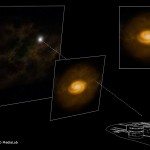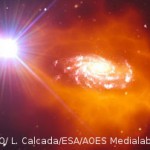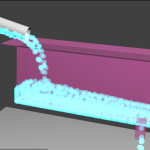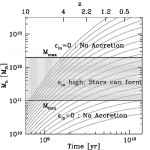- Signatures of Cool Gas Fueling a Star-Forming Galaxy at Redshift 2.3 , Bouché N. et al.,
Science, 2013 — ArXiv — ESO Press Release 1330 — UCSB PR — Swinburne PR —Video ESO ;
In this paper, we found a star-forming galaxy at redshift z=2 (2 Gyr after the Big Bang) which is located near a background light beacon (a quasar, which is an extremely bright compact object at the center of a galaxy):
This fortuitous situation enabled us to detect the presence of the galaxy surounding gas (see against the beacon light). What is more interesting is that the background source is aligned  with the galaxy major-axis, and this enables us to compare the gas kinematic properties to the galaxy rotation curve. We found that 50% of the gas cannot follow the galaxy rotation curve, and thus must be falling inwards at a rate comparable to the galaxy star-formation rate. This is in good agreement with theoretical predictions.
with the galaxy major-axis, and this enables us to compare the gas kinematic properties to the galaxy rotation curve. We found that 50% of the gas cannot follow the galaxy rotation curve, and thus must be falling inwards at a rate comparable to the galaxy star-formation rate. This is in good agreement with theoretical predictions.
News report: Huffington Post ; Wired UK ; Space.com ; SpaceDaily ; CSMonitor ; Nano Werk ; Universe Today ; Nouvel Observateur ; Techno-Science
- The Impact of cold gas accretion above a mass floor on galaxy scaling relations , Bouché N. et al., 2010, ApJ, 718, 1001 ArXiv
In this work, we studied the growth of galaxies and the links between the galaxy global properties and those of their (dark matter) halos. We showed that the gas content (the amount of gas in galaxies is its fuel, to make new generations of stars) of galaxies behaves like a self-regulated system, akin a bathtub. We showed that galaxies reach an equilibrium between the amount of gas coming in (from the intergalactic medium) and the one being used (by star-formation). Like in the bathtub, if the equilibrium is overshot (too much gas for the star-formation), then the Kennicutt-Schmidt law says that star-formation must rises (the pressure in the bathtub rises making the drain flowing faster) and a new equilibrium is reached where the star-formation rate is closely linked to the accretion rate. See the video here.
In the second part of this work, we showed there are several problems (too many stars in low mass galaxies for instance) if gas accretion is let to be given by the dark matter halo growth rate, as it is postulated. Many of these problems are not new, but most of them can be solved by making one ad-hoc change that is to allow the accretion only in a narrow mass range.
- The SINFONI MgII Program for Line Emitters (SIMPLE): Discovering starbursts near QSO sight lines, Bouché N. et al. 2007, ApJ ( ArXiv ) ESO Press Release 0740
In this work, we sheld light on the nature of the intergalactic medium, and in particular on a class of gas clouds selected by their Magnesium signature seen in absorption in the light of background quasars. Using the newly available 3D spectrograph SINFONI to european astronomers at one of the Very Large Telescopes, we were able to discover with a 70% success rate the host galaxy which turned out to be run-of-the-mill star-forming galaxies.
News report : Science Daily ; UK register ; Sydney ; Sc Alert AUS ; Innov. report ; Space ref. ; Calif. Sc. news ; Composed gentleman ; USAtoday